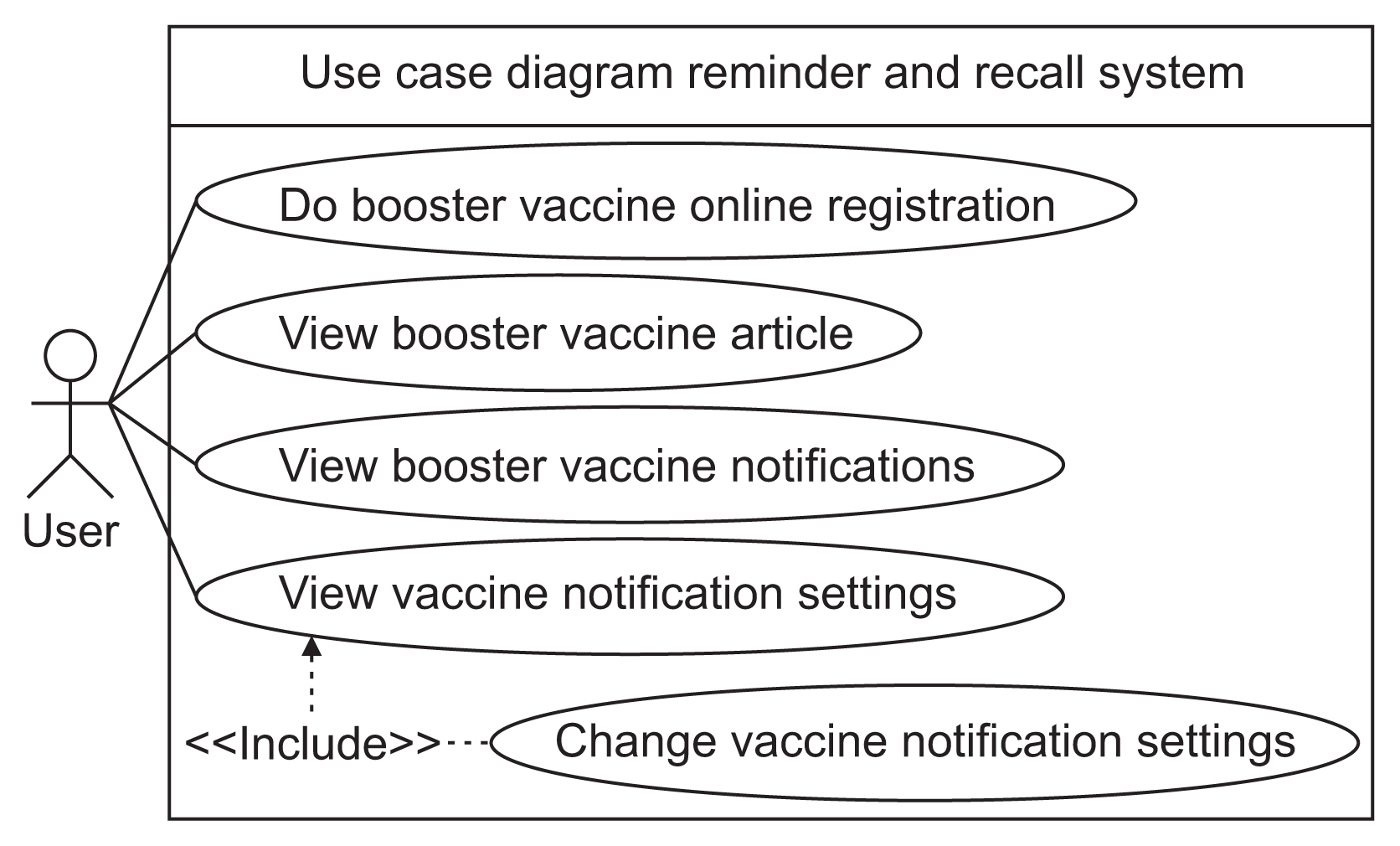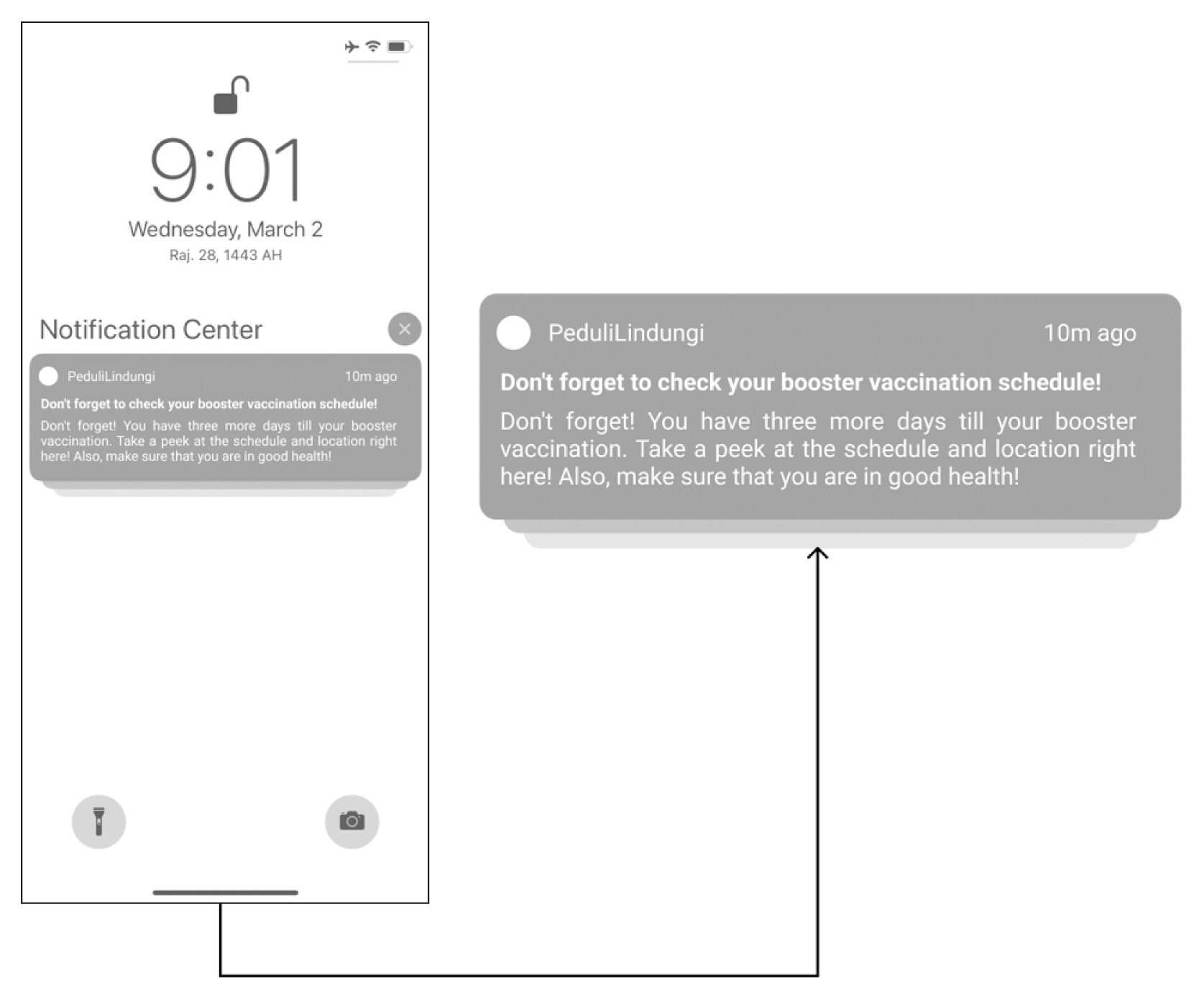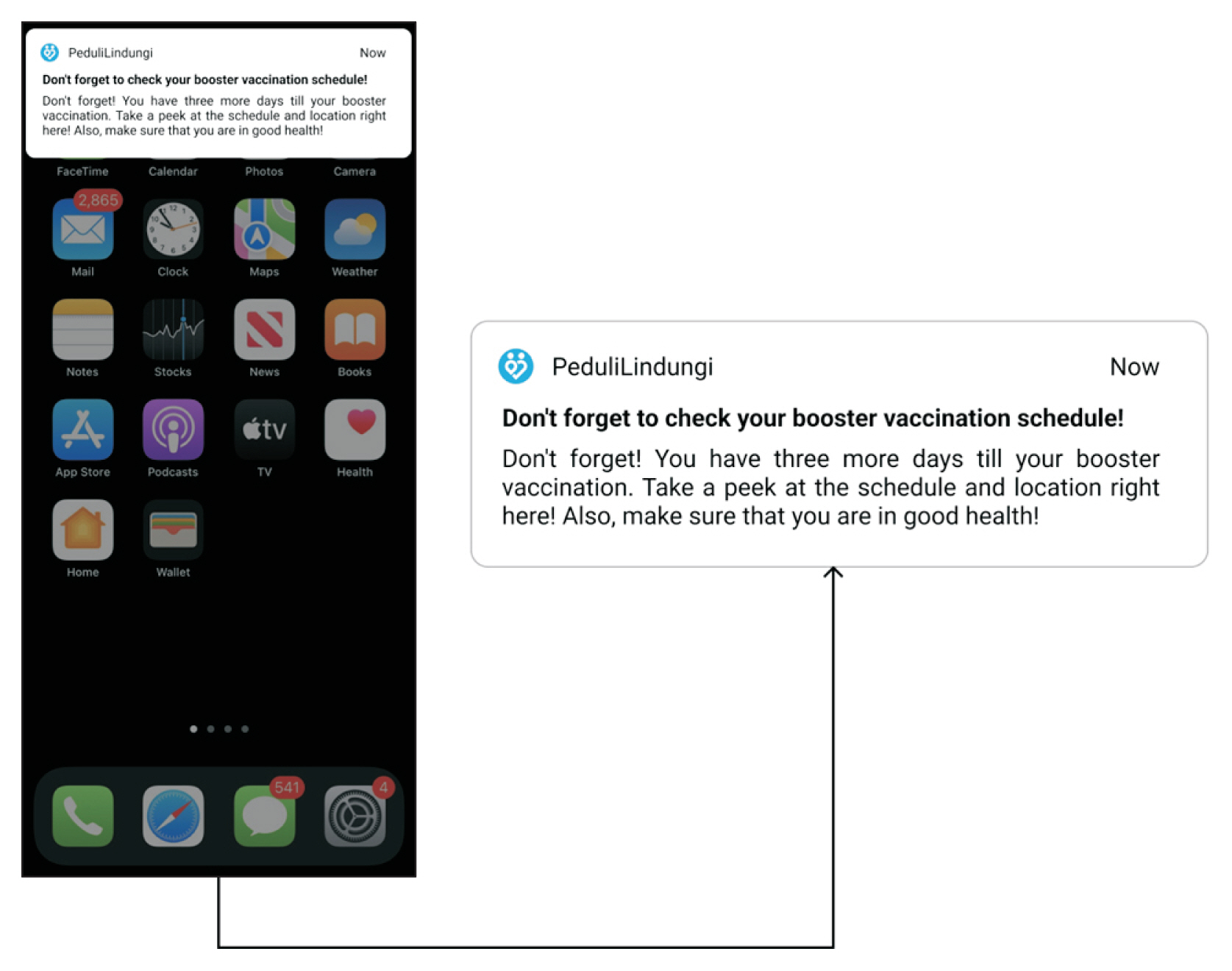Healthc Inform Res.
2023 Apr;29(2):93-102. 10.4258/hir.2023.29.2.93.
Design of a Reminder and Recall System in a Contact Tracing Application to Support Coronavirus Booster Vaccination
- Affiliations
-
- 1Faculty of Computer Science, Universitas Indonesia, West Java, Indonesia
- KMID: 2542135
- DOI: http://doi.org/10.4258/hir.2023.29.2.93
Abstract
Objectives
The rate of coronavirus disease 2019 (COVID-19) booster vaccination in Indonesia remains relatively low, representing 15.33% of the overall vaccination target as of April 2022. The implementation of a reminder and recall system has been shown to be effective in increasing vaccination rates. In prior research, reminders and recalls were sent through traditional media, such as mail, and had not yet been integrated into modern media, such as smartphone applications and (in particular) contact tracing applications. Therefore, the present study was conducted to design a reminder and recall system for the PeduliLindungi contact tracing application.
Methods
We used the design science research (DSR) methodology with three iterations. The first iteration produced a low-fidelity prototype (or wireframe), and the next yielded a high-fidelity (clickable) prototype.
Results
The final prototype included three main features: a reminder and recall mechanism, online registration for COVID-19 booster vaccination, and educational articles. The evaluation consisted of interviews in the first iteration, interviews and the System Usability Scale (SUS) questionnaire in the second, and the Post-Study System Usability Questionnaire (PSSUQ) in the third. The SUS value obtained in the second iteration was 71.6, indicating good (acceptable) results, while in the third iteration, the system usefulness, information quality, interface quality, and overall PSSUQ values were 2.456, 2.473, 2.230, and 2.397, respectively, indicating good quality of the resulting design.
Conclusions
This research contributes to two areas: implementation of a reminder and recall system in the PeduliLindungi contact tracing application and enhancement of contact tracing applications using DSR methodology.
Figure
Reference
-
References
1. Lau CS. Can COVID-19 vaccines stop the pandemic? Hong Kong Med J. 2021; 27(2):84–5. https://doi.org/10.12809/hkmj215116.
Article2. Rokom . The Ministry of Health issues a circular on the implementation of booster vaccinations in all regions [Internet]. Jakarta, Indonesia: Sehat Negeriku;2022. [cited at 2023 Mar 10]. Available from: https://sehatnegeriku.kemkes.go.id/baca/rilis-media/20220113/4539153/kemenkes-terbitkan-surat-edaran-pelaksanaan-vaksinasi-booster-di-semua-wilayah/.3. Saptohutomo AP. Many are confused, is Covid-19 booster vaccination mandatory or not? [Internet]. Jakarta, Indonesia: Kontan News;2022. [cited at 2023 Mar 10]. Available from: https://newssetup.kontan.co.id/news/banyak-yang-bingung-vaksinasi-booster-covid-19-wajib-atau-tidak?page=all.4. Ministry of Health, Republic of Indonesia. National COVID-19 vaccination [Internet]. Jakarta, Indonesia: Ministry of Health, Republic of Indonesia;2022. [cited at 2023 Mar 10]. Available from: https://vaksin.kemkes.go.id/#/vaccines.5. Coley S, Hoefer D, Rausch-Phung E. A population-based reminder intervention to improve human papillomavirus vaccination rates among adolescents at routine vaccination age. Vaccine. 2018; 36(32 Pt B):4904–9. https://doi.org/10.1016/j.vaccine.2018.06.056.
Article6. Dombkowski KJ, Cowan AE, Reeves SL, Foley MR, Dempsey AF. The impacts of email reminder/recall on adolescent influenza vaccination. Vaccine. 2017; 35(23):3089–95. https://doi.org/10.1016/j.vaccine.2017.04.033.
Article7. Hurley LP, Beaty B, Lockhart S, Gurfinkel D, Breslin K, Dickinson M, et al. RCT of centralized vaccine reminder/recall for adults. Am J Prev Med. 2018; 55(2):231–9. https://doi.org/10.1016/j.amepre.2018.04.022.
Article8. Jong KM, Sikora CA, MacDonald SE. Childhood immunization appointment reminders and recalls: strengths, weaknesses and opportunities to increase vaccine coverage. Public Health. 2021; 194:170–5. https://doi.org/10.1016/j.puhe.2021.02.034.
Article9. Szilagyi PG, Albertin CS, Saville AW, Valderrama R, Breck A, Helmkamp L, et al. Effect of state immunization information system based reminder/recall for influenza vaccinations: a randomized trial of autodialer, text, and mailed messages. J Pediatr. 2020; 221:123–31e4. https://doi.org/10.1016/j.jpeds.2020.02.020.
Article10. Yunusa U, Ibrahim AH, Ladan MA, Gomaa HE. Effect of mobile phone text message and call reminders in the completeness of pentavalent vaccines in Kano state, Nigeria. J Pediatr Nurs. 2022; 64:e77–e83. https://doi.org/10.1016/j.pedn.2021.12.026.
Article11. Centers for Disease Control and Prevention (CDC). Recommendations of the Advisory Committee on Immunization Practices, the American Academy of Pediatrics, and the American Academy of Family Physicians: use of reminder and recall by vaccination providers to increase vaccination rates. MMWR Morb Mortal Wkly Rep. 1998; 47(34):715–7.12. Szilagyi PG, Bordley C, Vann JC, Chelminski A, Kraus RM, Margolis PA, et al. Effect of patient reminder/recall interventions on immunization rates: a review. JAMA. 2000; 284(14):1820–7. https://doi.org/10.1001/jama.284.14.1820.
Article13. Bell CA, Simmonds KA, MacDonald SE. Exploring the heterogeneity among partially vaccinated children in a population-based cohort. Vaccine. 2015; 33(36):4572–8. https://doi.org/10.1016/j.vaccine.2015.07.004.
Article14. Lemstra M, Rajakumar D, Thompson A, Moraros J. The effectiveness of telephone reminders and home visits to improve measles, mumps and rubella immunization coverage rates in children. Paediatr Child Health. 2011; 16(1):e1–5. https://doi.org/10.1093/pch/16.1.e1.
Article15. Thomas M, Kohli V, King D. Barriers to childhood immunization: findings from a needs assessment study. Home Health Care Serv Q. 2004; 23(2):19–39. https://doi.org/10.1300/J027v23n02_02.
Article16. Schnall R, Rojas M, Travers J, Brown W, Bakken S. Use of design science for informing the development of a mobile app for persons living with HIV. AMIA Annu Symp Proc. 2014; 2014:1037–45.17. Behne A, Kruger N, Beinke JH, Teuteberg F. Learnings from the design and acceptance of the German COVID-19 tracing app for IS-driven crisis management: a design science research. BMC Med Inform Decis Mak. 2021; 21(1):238. https://doi.org/10.1186/s12911-021-01579-7.
Article18. Peffers K, Tuunanen T, Rothenberger MA, Chatterjee S. A design science research methodology for information systems research. J Manag Inf Syst. 2007; 24(3):45–77. https://doi.org/10.2753/MIS0742-1222240302.
Article19. Cross N. Designerly ways of knowing: design discipline versus design science. Des Issues. 2001; 17(3):49–55.
Article20. Fruhling A, Lee S. Assessing the reliability, validity and adaptability of PSSUQ. In : Proceedings of the 11th Americas Conference on Information Systems (AMCIS); 2005 Aug 11–14; Omaha, NE.
- Full Text Links
- Actions
-
Cited
- CITED
-
- Close
- Share
- Similar articles
-
- Is the Use of Physician Reminder Sticker on Medical Records Effective for Improving the Rate of Recommending Influenza Vaccination?
- Contact Transmission of COVID-19 in South Korea: Novel Investigation Techniques for Tracing Contacts
- A Case of de novo MPO-associated Central Nervous System Vasculitis Following Heterogeneous mRNA1273 COVID-19 Booster Vaccination
- Herd immunity: challenges and the way forward in Korea
- The Values of Tetanus Toxoid Specific IgG Immunoglobulins in Children






